Monthly Archives: September 2024
Women Design: Lucia DeRespinis & the Beehive Lamp

Prototype Beehive Hanging Lamp, 1960. / THF370555
When Lucia DeRespinis designed the Beehive Lamp in 1960, she was the only female industrial designer at the George Nelson Associates design firm in New York City. The firm is often remembered for its connection to the Herman Miller Furniture Company where its founder, George Nelson, served as design director for decades, but George Nelson Associates worked with and for a variety of companies during its long tenure. One such collaboration was with renowned lighting company Nessen Studios to design a series of versatile indoor/outdoor lighting. DeRespinis was put on the project and the Beehive Lamp she designed for the series is one of her more celebrated product designs today. This particular Beehive Lamp, acquired by The Henry Ford in 2023, is likely the second prototype, DeRespinis posited. It cannot be the first prototype—although it is nearly identical to it—as that one sits in DeRespinis’ own home, above her dining room table.
Lucia Neumann was born in 1927 in Cleveland, Ohio. She initially attended St. Lawrence University but transferred to the Pratt Institute, graduating with a bachelor’s degree in industrial design in 1952, as one of just a few women in her class. She first worked for the design office of Monte Levin before hearing about an open position at George Nelson Associates. She was hired as George Nelson’s first female industrial designer in 1956 and shortly after, in 1957, married Pratt classmate and fellow industrial designer, Louis DeRespinis. While employed by George Nelson, Lucia DeRespinis designed the iconic Eye and Spindle clocks for Howard Miller, interiors of an apartment at the 1959 American National Exhibition in Moscow, dinnerware for Hall China Co., and more—although she has only recently received credit for this work. As was common in the mid-twentieth century, the lead designer (in this case, George Nelson) received credit for all work completed by the eponymous design firm.

Underside of the Prototype Beehive Hanging Lamp, 1960. / THF370558
DeRespinis left George Nelson Associates in 1963, when she was “too pregnant to lean over the drafting table.” She became a freelance designer, and her contracted work varied from designing interiors for television news programs to logos and packaging design. In 1970, Lucia’s husband Louis tragically passed away, leaving her a single mother. With the help of her building’s babysitting co-op, DeRespinis continued to freelance design. In 1975, while working with advertising firm Sandgren & Murtha, she selected the vibrant orange and fuchsia colorway of the Dunkin’ Donuts logo, inspired by the favorite colors of her daughter—because she thought “donuts are fun!” and that the logo should reflect that playfulness. Although the Dunkin’ Donuts logo has been altered in the decades since, what remains is DeRespinis’ iconic orange and fuchsia.
DeRespinis returned to Pratt Institute in 1980. She spent decades teaching generations of designers as a professor in the Department of Industrial Design at Pratt Institute and retired in 2020. She lives in the same I.M. Pei-designed Manhattan apartment complex that she and Louis moved into in 1965.
Katherine White is curator of design at The Henry Ford. Katherine is grateful to Lucia DeRespinis for generously opening her home and sharing stories of her life’s work.
What We Wore: Off to Work We Go
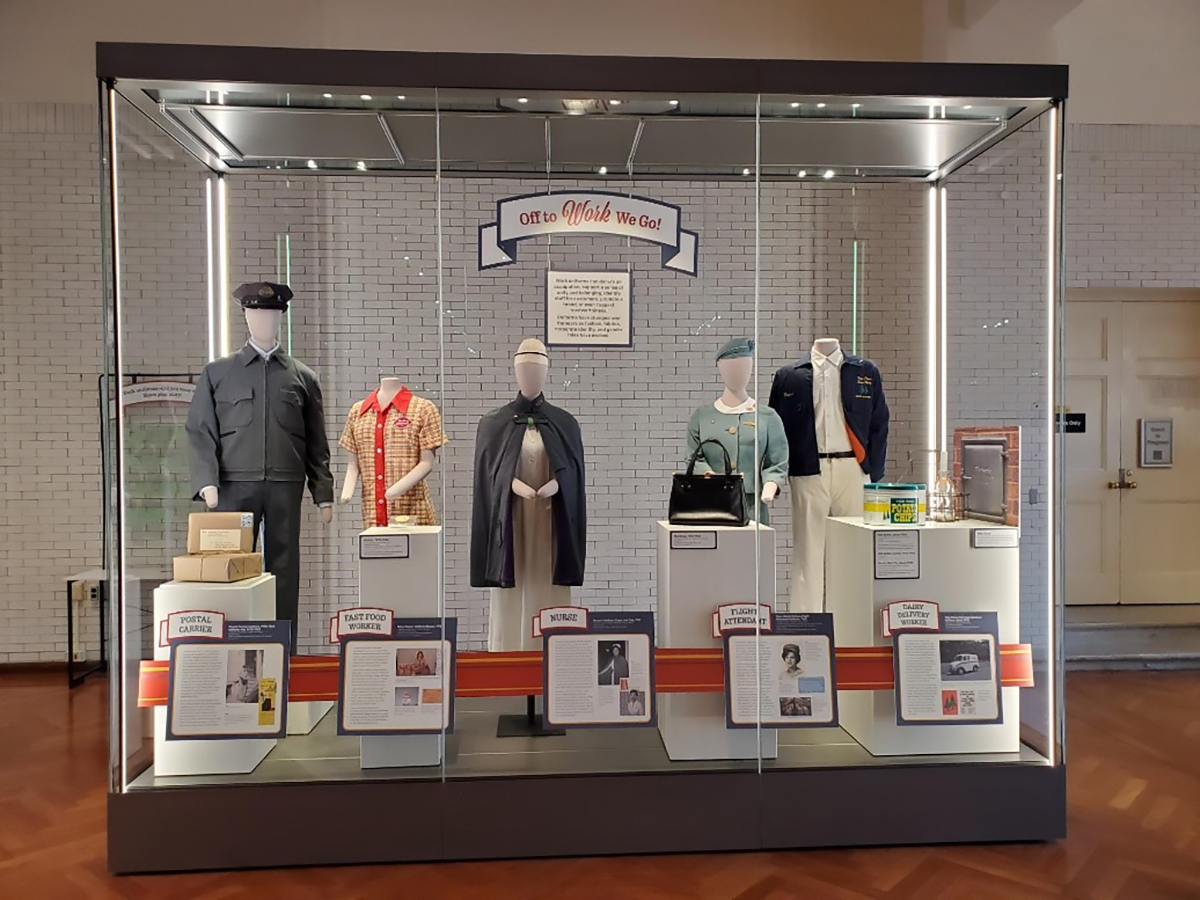
Through mid-December 2024, the What We Wore exhibit in Henry Ford Museum of American Innovation presents work “fashions” — and a bit of work lives — of a postal carrier, fast food worker, nurse, flight attendant, and dairy delivery worker.
Work uniforms can denote an occupation, support a sense of unity and belonging, identify staff for customers, promote a brand, or even suggest trustworthiness.
Uniforms have changed over the years as fashion, fabrics, corporate identity, and gender roles have evolved.
Postal Carrier
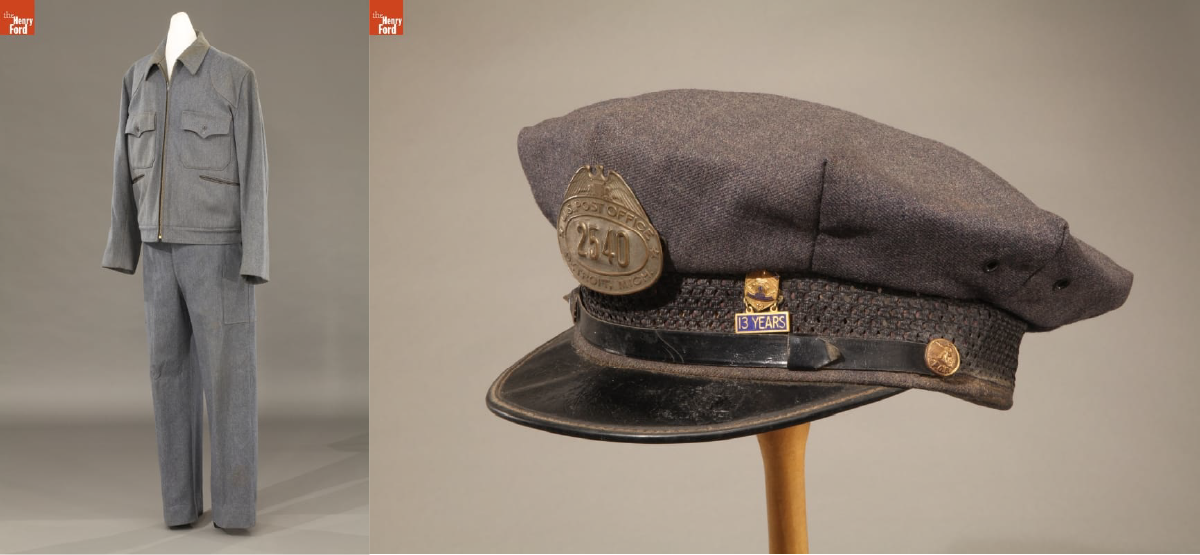
Postal carrier uniform and hat, 1955-1965. Worn by Herbert Temple Goltry of Allen Park, Michigan. / THF152804, THF152867
Uniforms worn by U.S. Postal Service carriers are designed for comfort and function. Created in regulation styles and colors — with some local variation — these uniforms are instantly recognizable and imply that the wearer is a trustworthy government employee. Carrier uniforms adopted the "Eisenhower jacket" look in 1953. This practical, yet smart, waist-length jacket, named after General Dwight D. Eisenhower, was developed for the U.S. Army during World War II. The eight-point cap — made with a woven cane band for ventilation — became the mandatory cap style for carriers beginning in 1955.
In 1913, the U.S. Post Office began Parcel Post, offering delivery service for packages weighing over 4 pounds to customers across the nation. Herbert Goltry, the wearer of this uniform, delivered parcel post packages from the 1940s into the 1970s. Post Office patch design and trouser stripe colors were changed from time to time and no longer appear on this uniform.
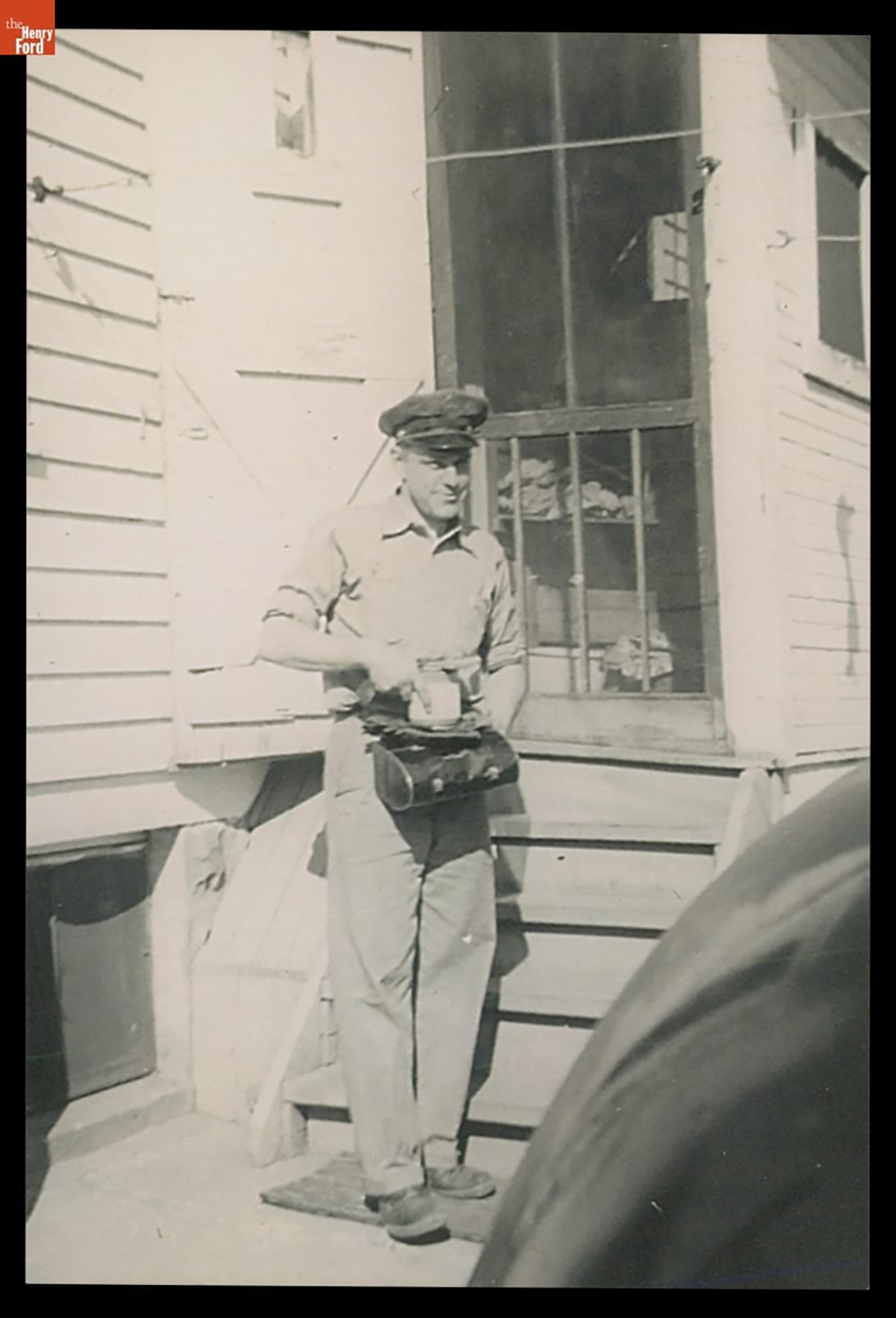
Herbert Goltry wearing a postal carrier's uniform, 1940-1945. / THF717914.
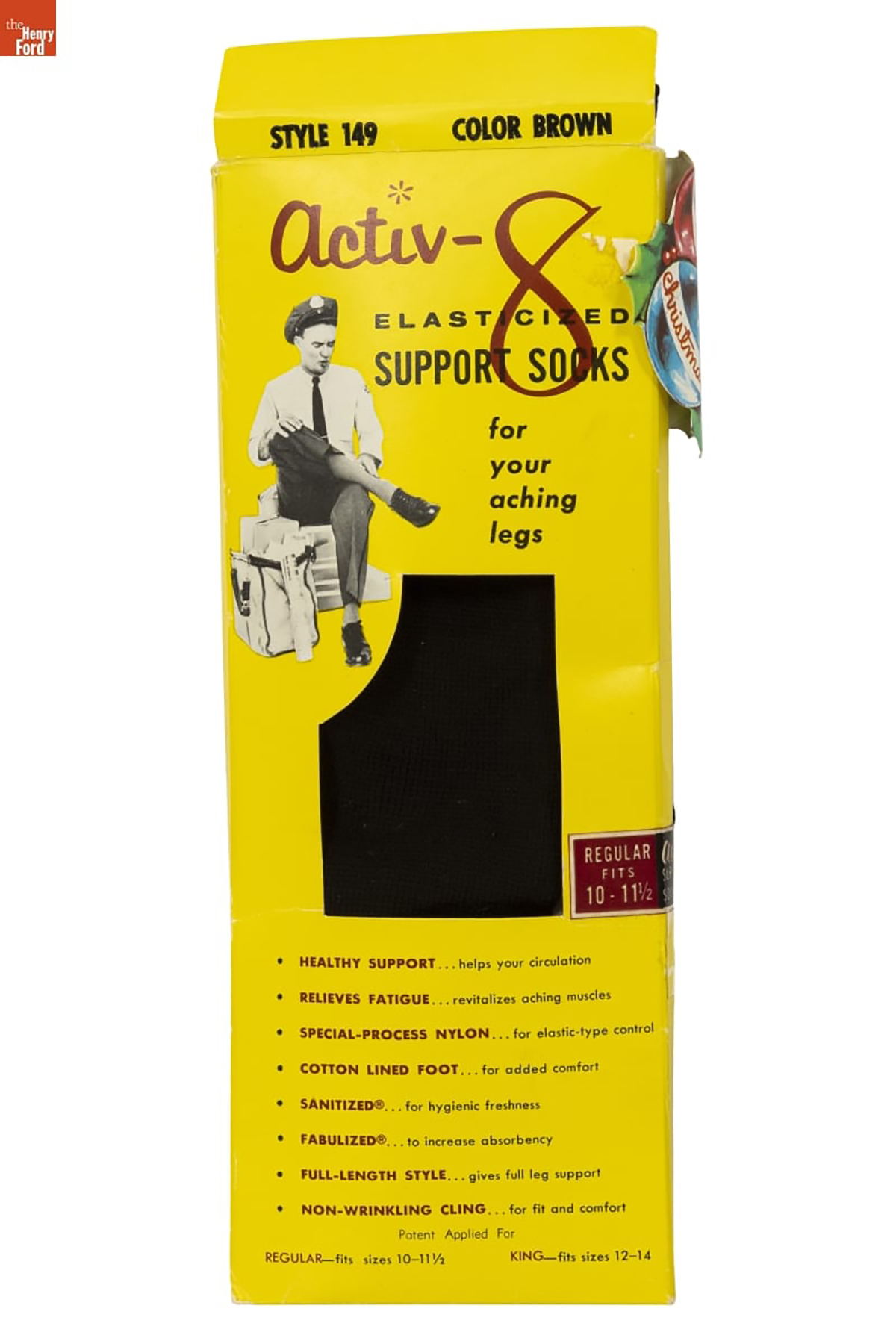
Postal carriers are known to spend a lot of time on their feet. These Jerk brand "Activ-8" elasticized support socks use the image of a postman as an “endorsement” of their product. 1955-1960. / THF196279
Fast Food Worker
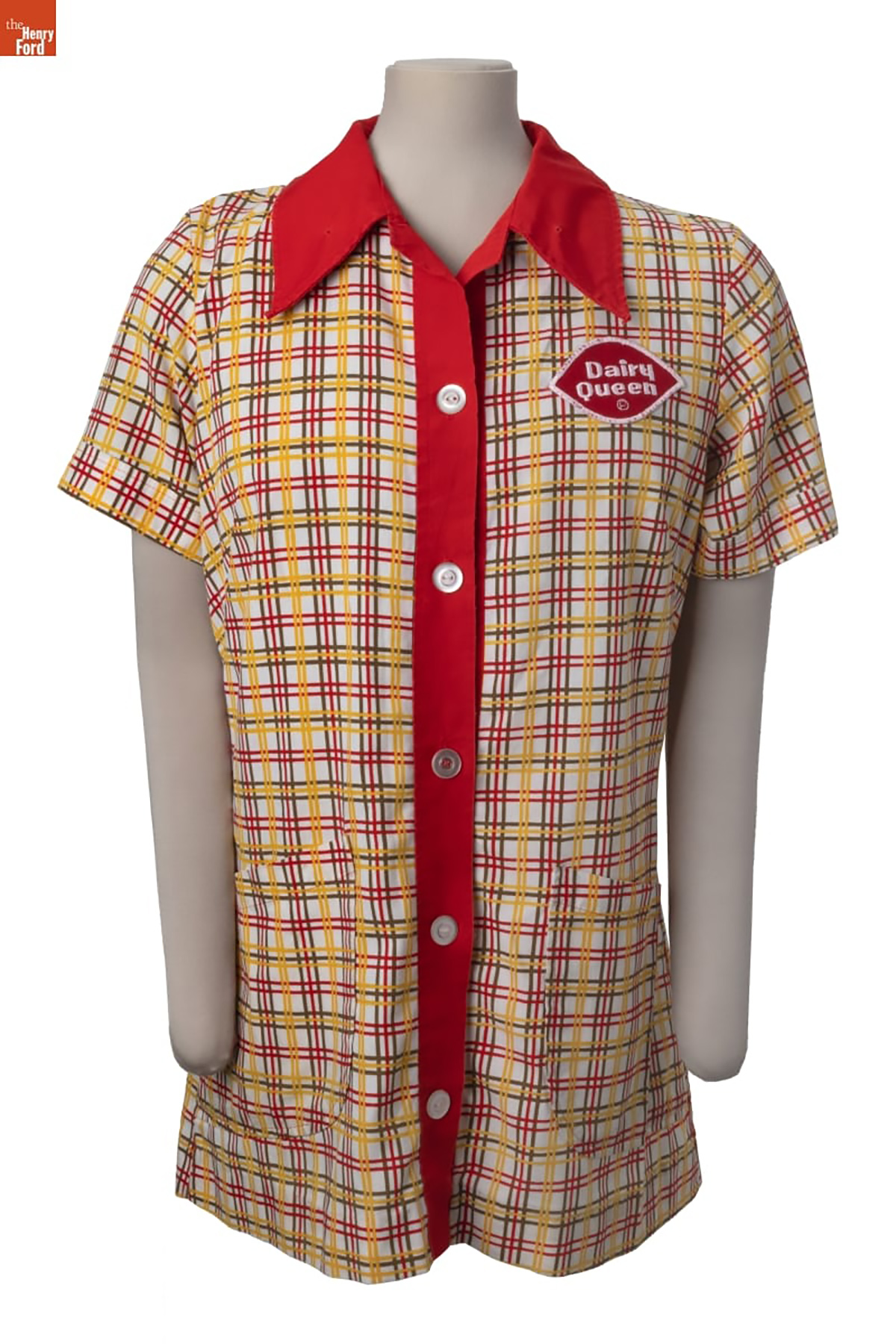
Dairy Queen uniform blouse, 1978. Worn by Laura Gentry of Harvester, Missouri. / THF372105 Gift of Laura (Gentry) Stupperich
A growing number of fast food restaurants have become part of the American landscape since the mid-20th century — jobs at these restaurants are often among a teen’s first. Wearing a uniform that represents the company's brand is part of the experience.
Laura Gentry worked at Dairy Queen in Harvester, Missouri, from her senior year in high school through college. She wore this distinctive uniform blouse — brown, red, and gold plaid — along with dark brown pants purchased on her own.
Laura dove in, preparing ice cream orders, dealing with customers, handling money, cleaning tables, and mopping floors. She loved making the iconic Dairy Queen curly twist on top of the soft-serve ice cream cones.
Laura's hard work earned her a management role at the restaurant while she attended college classes for a career in accounting. Her family had wanted her to go places. For Laura, her experiences at Dairy Queen paved the way.
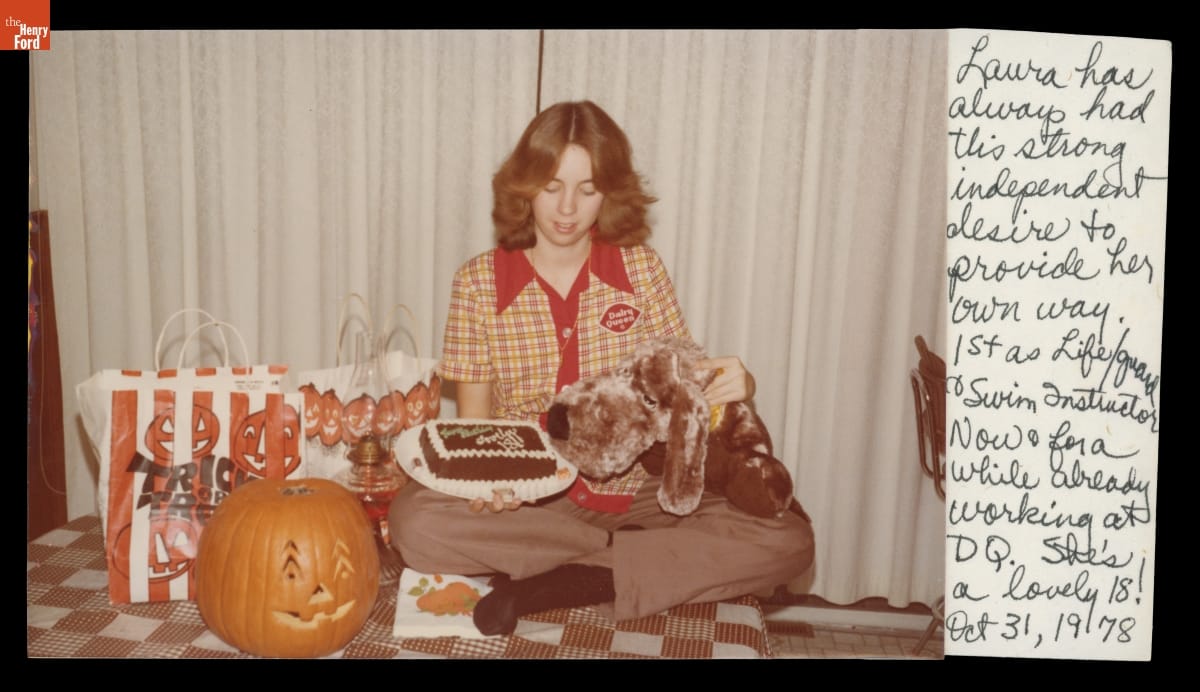
Laura Gentry posed on her Halloween birthday in 1978--then headed off to her job at Dairy Queen! / THF718996 Gift of Laura (Gentry) Stupperich
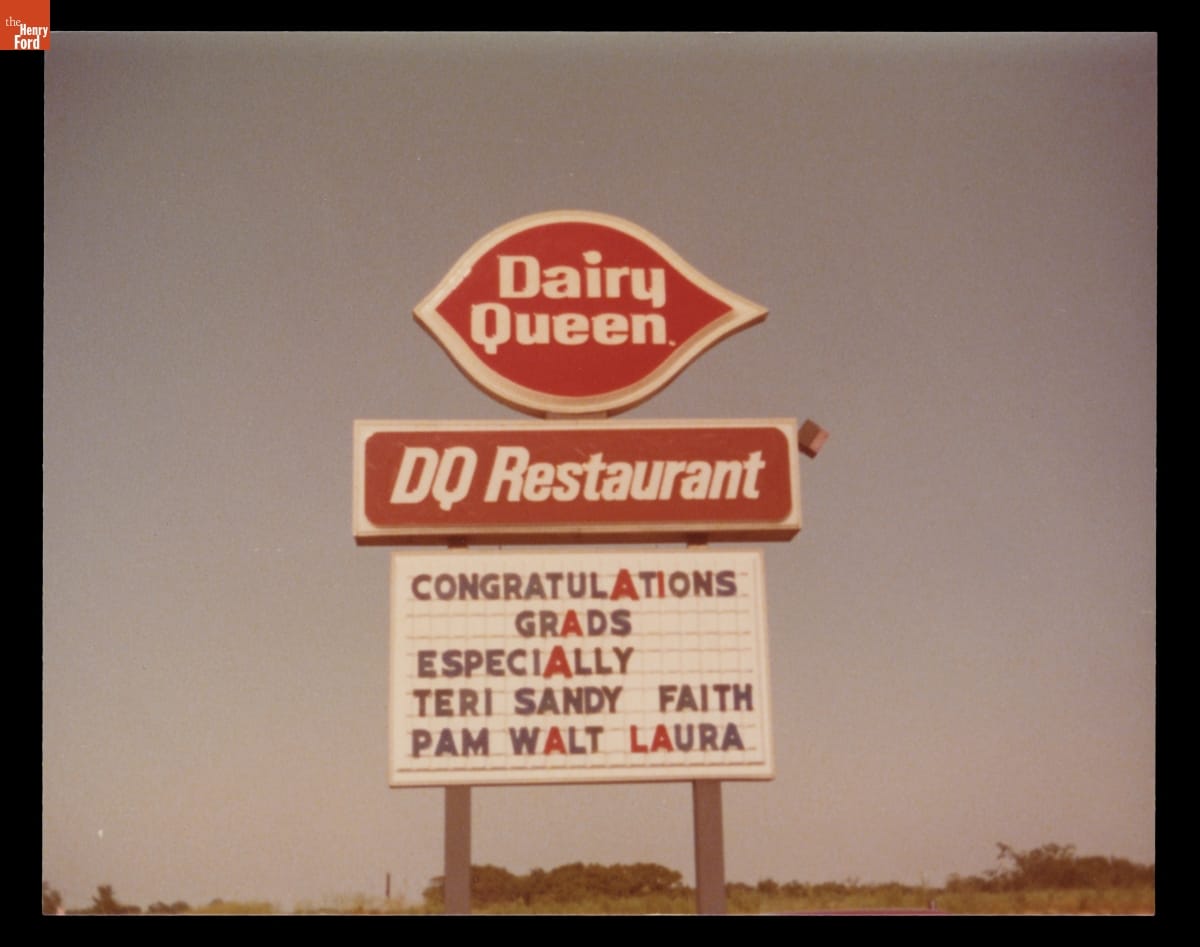
When Laura Gentry and her Dairy Queen coworkers graduated from high school in 1979, the restaurant's sign took note. / THF718998 Gift of Laura (Gentry) Stupperich.
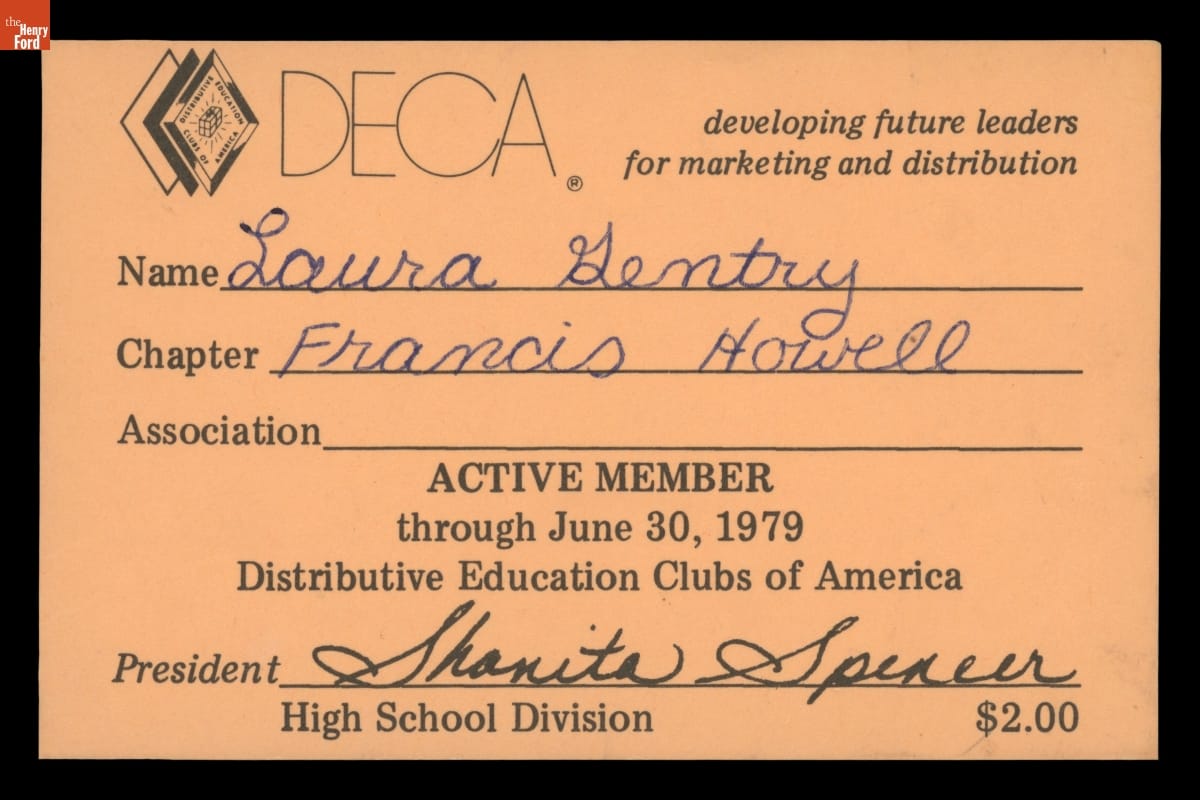
Laura Gentry's job at Dairy Queen was part of DECA, a program aimed at providing work experience for high school students. / THF719001 Gift of Laura (Gentry) Stupperich.
Nurse
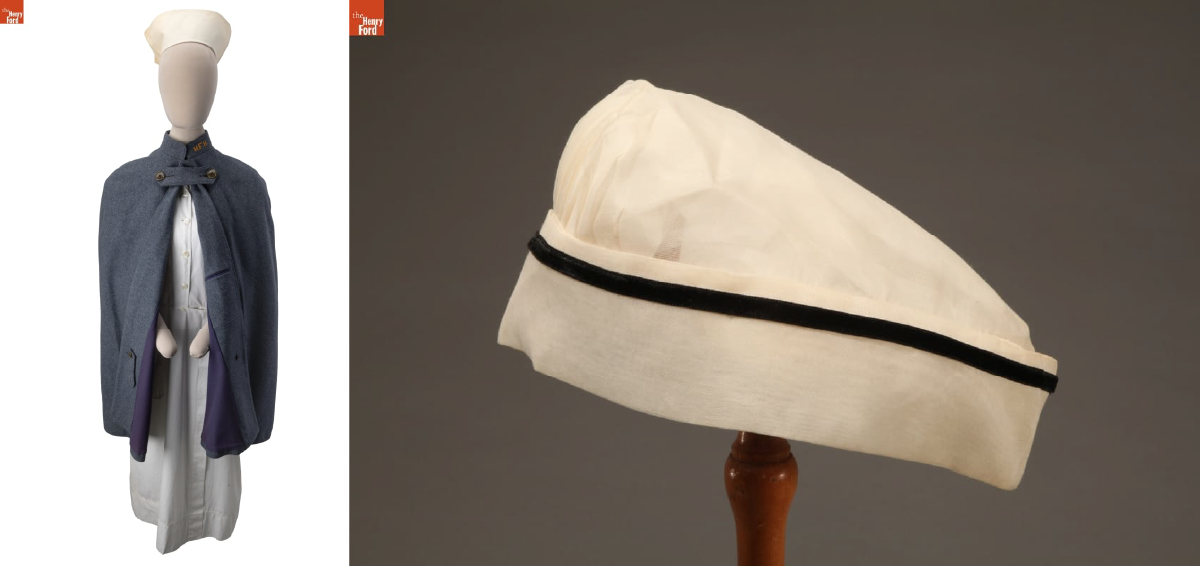
Nurse's uniform, cape, and cap, 1957. Worn by Marie Goltry of Allen Park, Michigan. / THF371971, THF152866.
Nursing is a demanding job that requires specialized training — and until recent decades, it was predominantly a woman's profession. Marie Goltry was one of more than 5,000 nurses who graduated from the Henry Ford Hospital School of Nursing in Detroit during its 71 years of service. In the mid-20th century, college programs would begin to replace hospital-based education.
For decades, nurses' uniforms were white — in the early 1900s white was considered more sanitary and scientific. Nurses wore a crisp white dress, white cap, white hose, and sturdy white shoes. The uniform was reassuring to patients who knew their care was in the hands of a trained professional.
Wearing a white dress and cap — and keeping them spotless — was often impractical in a healthcare setting. By the 1980s, clothing for nurses took a more practical turn. Scrubs were easier to move in, keep clean, and came in fabrics that let the wearer express their individuality — and scrubs were gender neutral, as men joined the nursing profession.
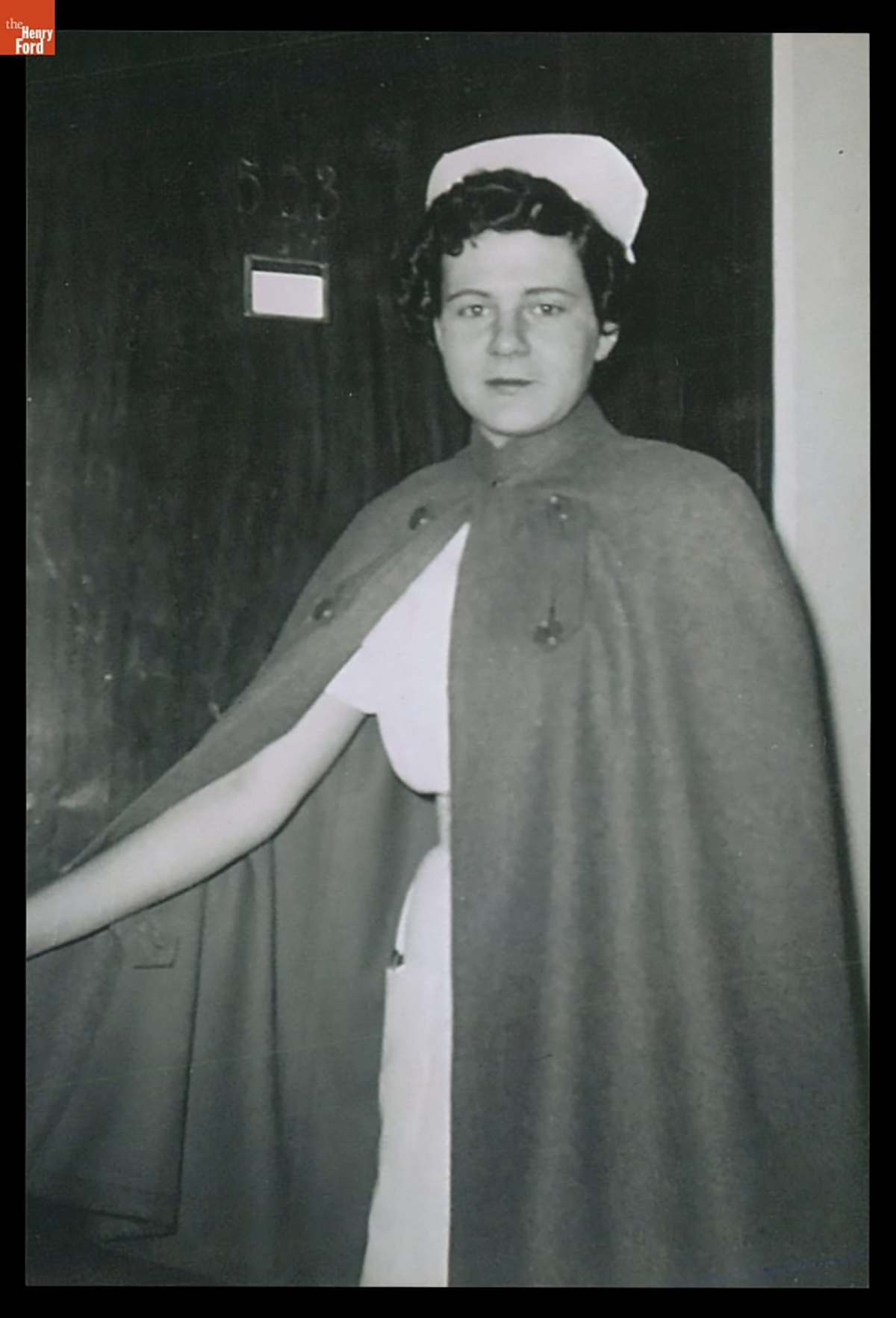
Marie Goltry poses in her uniform after graduating from Henry Ford Hospital Nursing School in 1957. "Ford grads," like nurses who graduated from other training programs, were easily recognized by their unique caps. THF717912
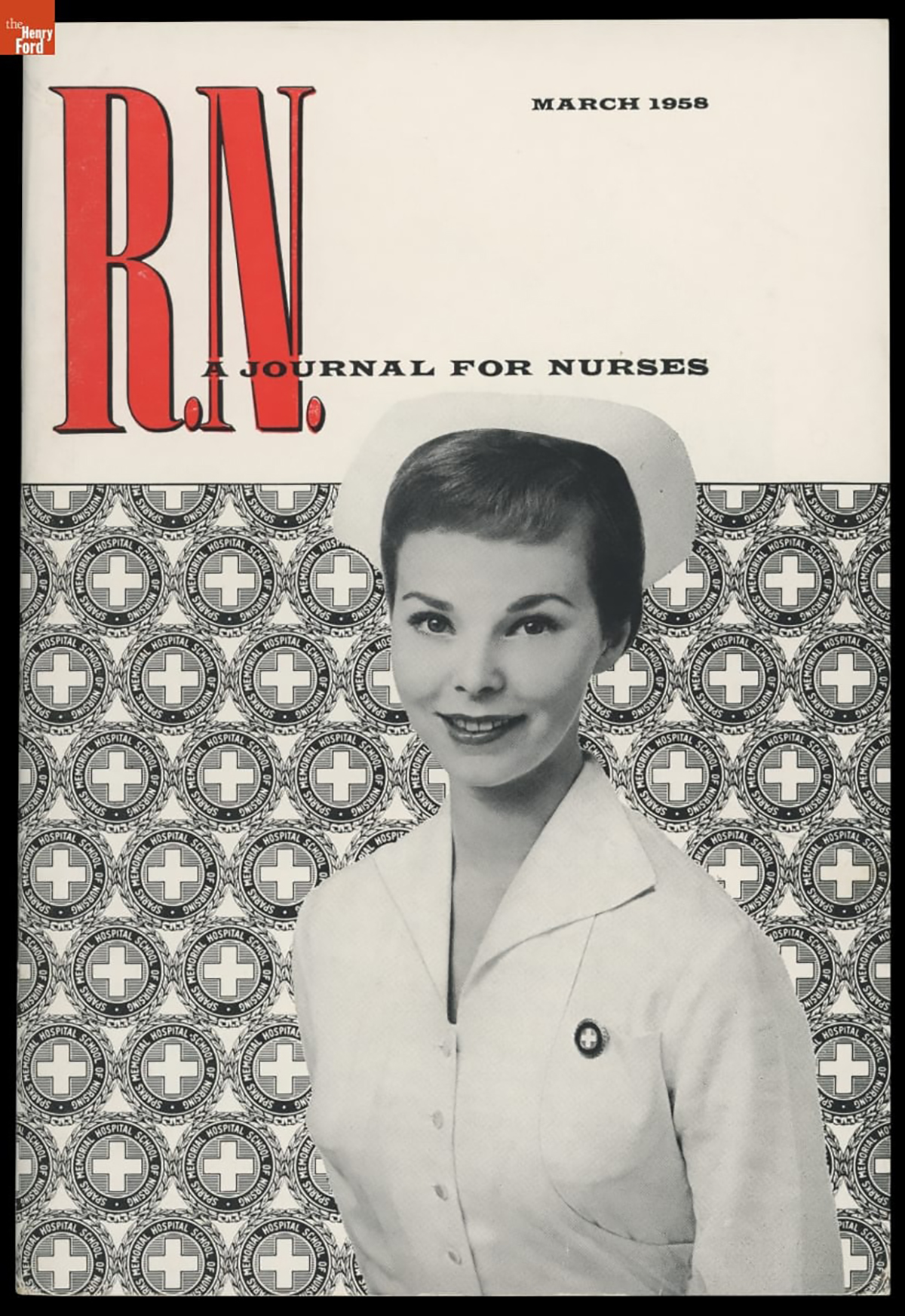
Journals helped nurses learn of new developments in health and health care. R.N.: A Journal for Nurses, March 1958. THF719176
Flight Attendant
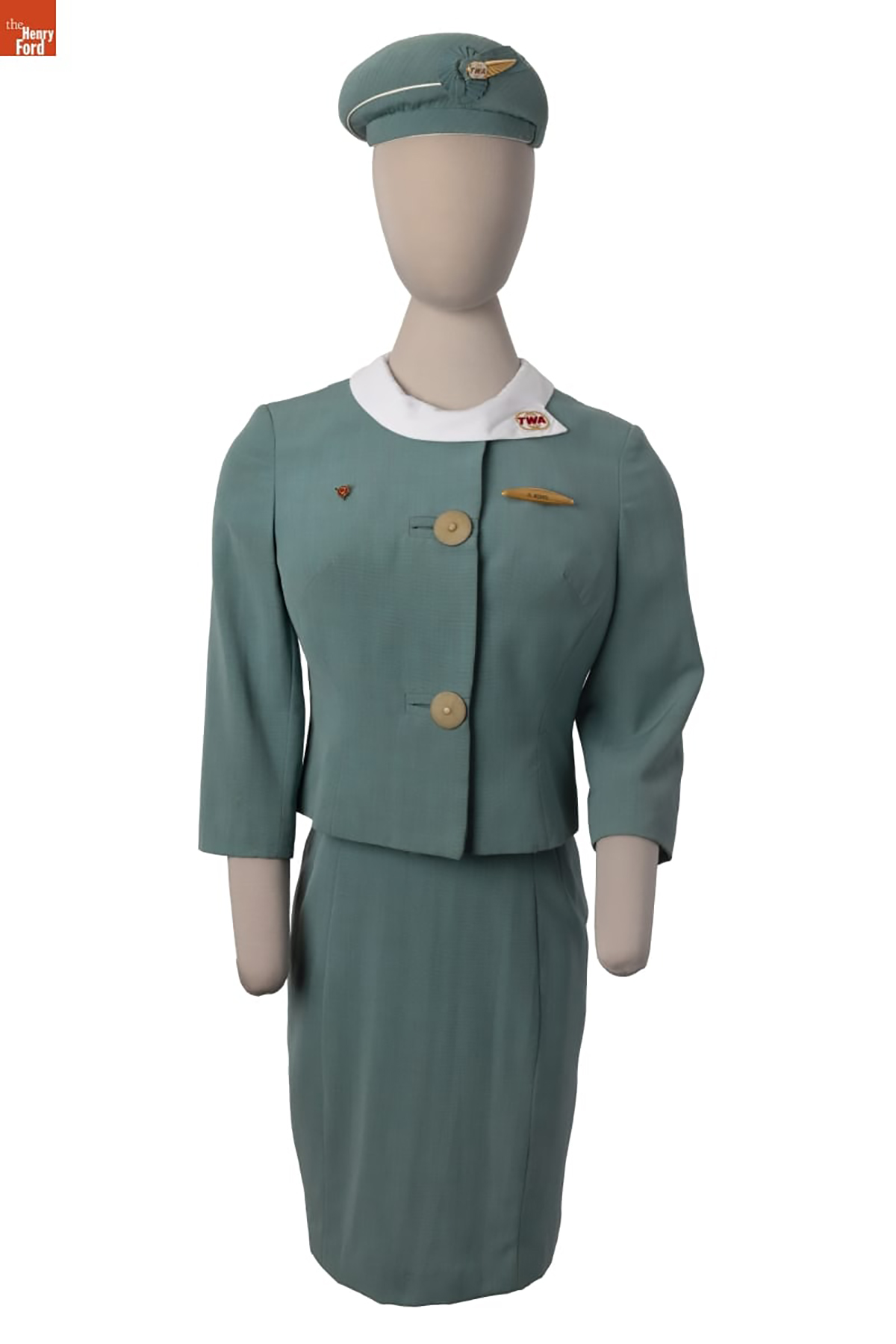
Trans World Airlines flight attendant uniform, 1965. Worn by Diane Beers of East Orange, New Jersey. / THF372094 Gift of Diane B. Hill.
In the 1960s, when flying was still an adventure for many, being a flight attendant — or stewardess as they were then known — offered an exciting career choice for young women. Winging one's way to destinations across the country or around the globe had great appeal.
In an era when most airline travelers were men, most flight attendants were women — young, attractive, and well-groomed. Uniforms by prominent designers — like TWA's French-inspired contemporary look by couturier Pierre Balmain — gave women like Diane Beers of New Jersey an enviably sophisticated air.
Competition for jobs was intense and expectations high. A stewardess was expected to handle with smooth professionalism the hospitality and safety needs of dozens of passengers. Her appearance was carefully regulated, including regular weigh-ins. Well into the 1960s, airline careers for women were usually short, ending with marriage or with women aging out in their early 30s.
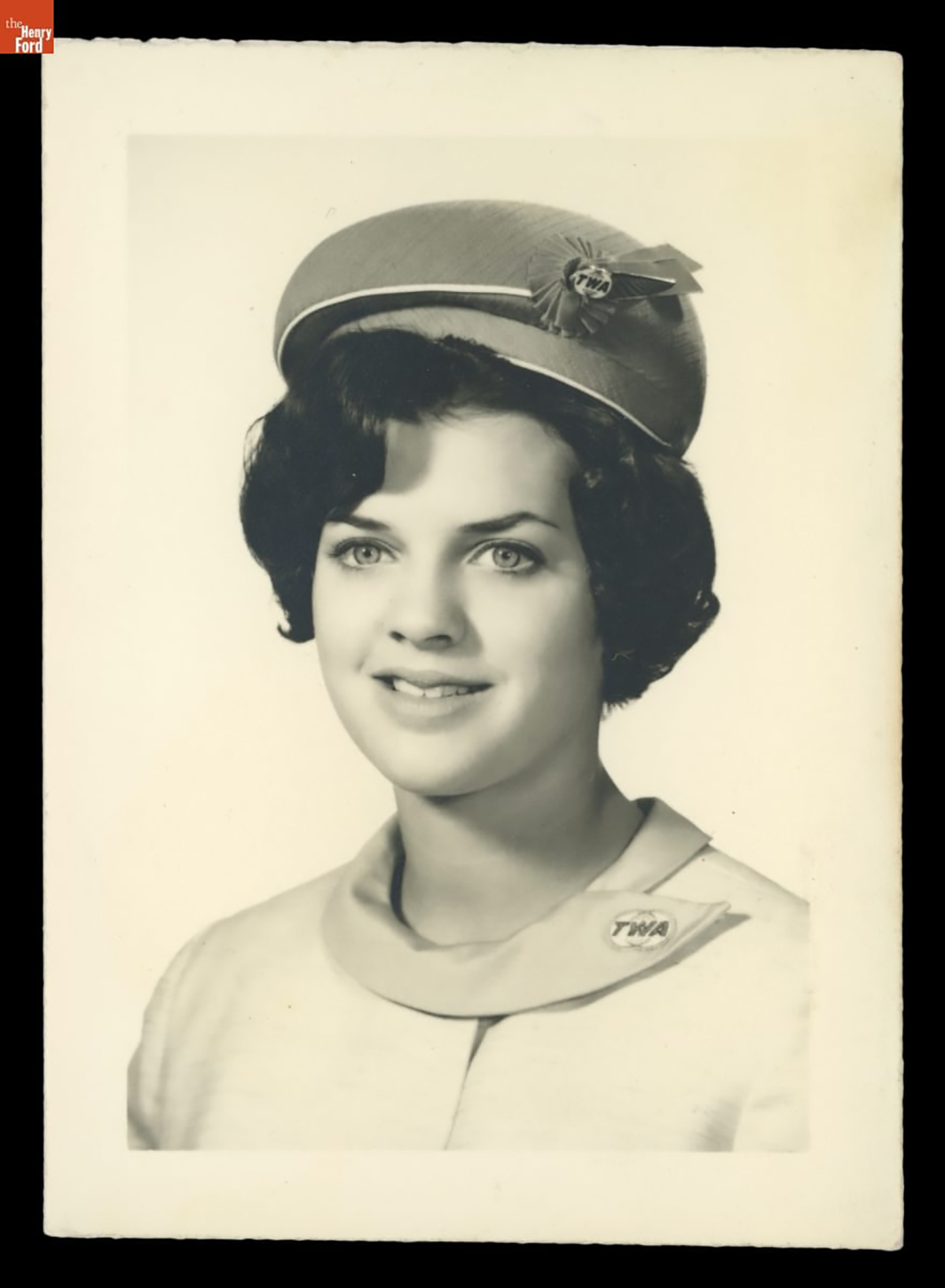
Diane Beers joined TWA as an “air hostess” after earning an associate degree — major airlines often hired women with a college education. Here, Diane Beers poses proudly in her Pierre Balmain-designed TWA uniform, 1965. / THF718807 Gift of Diane B. Hill.
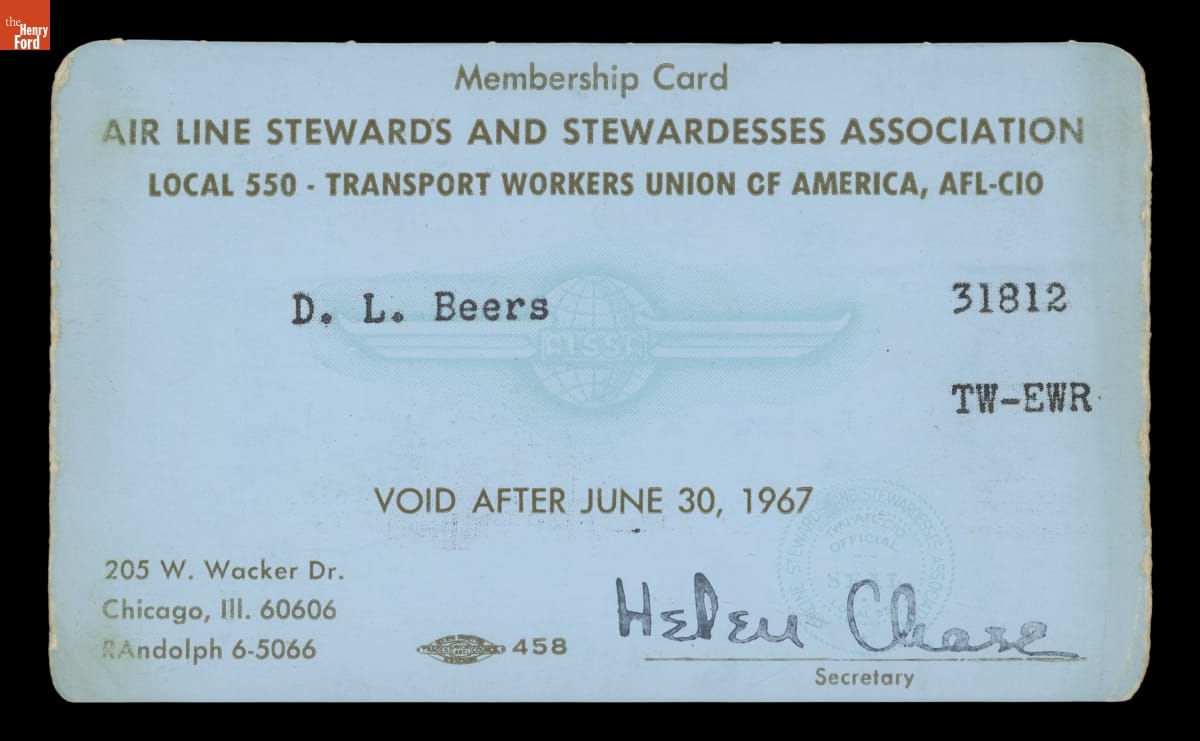
Air Line Stewards and Stewardesses Association membership card for Diane L. Beers, 1965. / THF718792 Gift of Diane B. Hill.
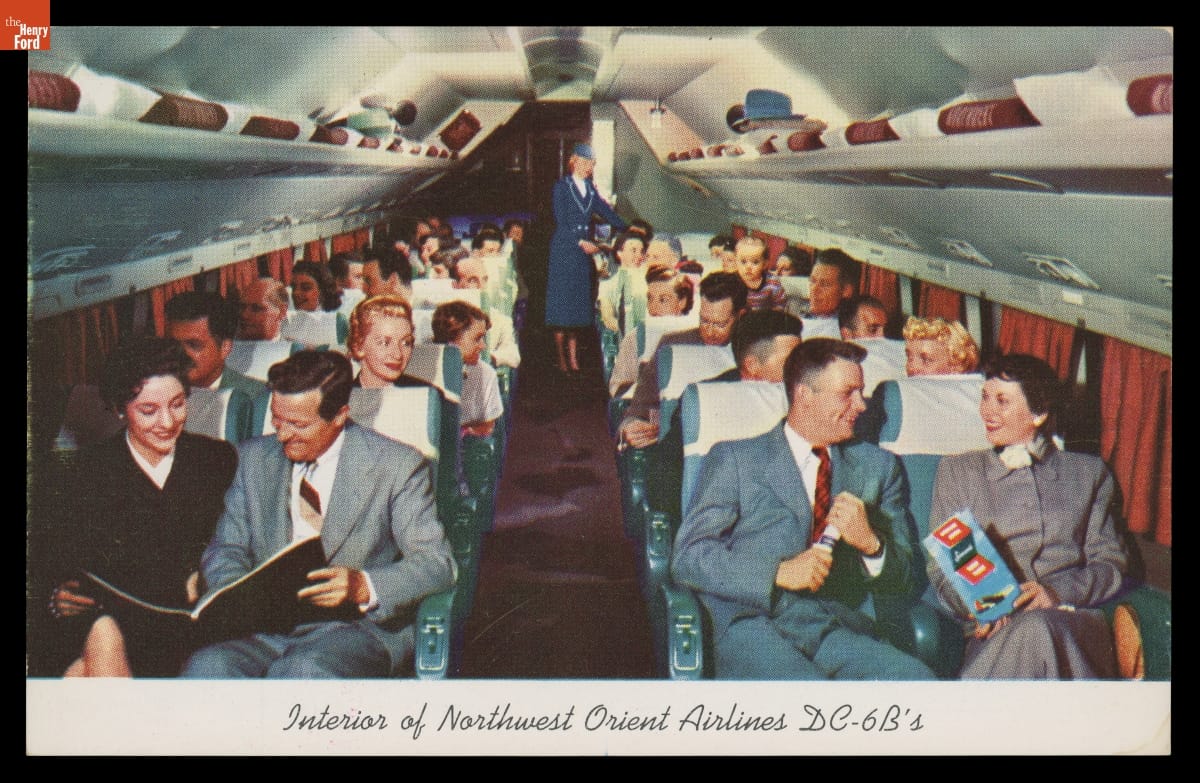
Flying was an event in the 1950s and 1960s. Stewardesses presented a polished appearance and professional demeanor as they served passengers. / THF717916
Dairy Delivery Worker
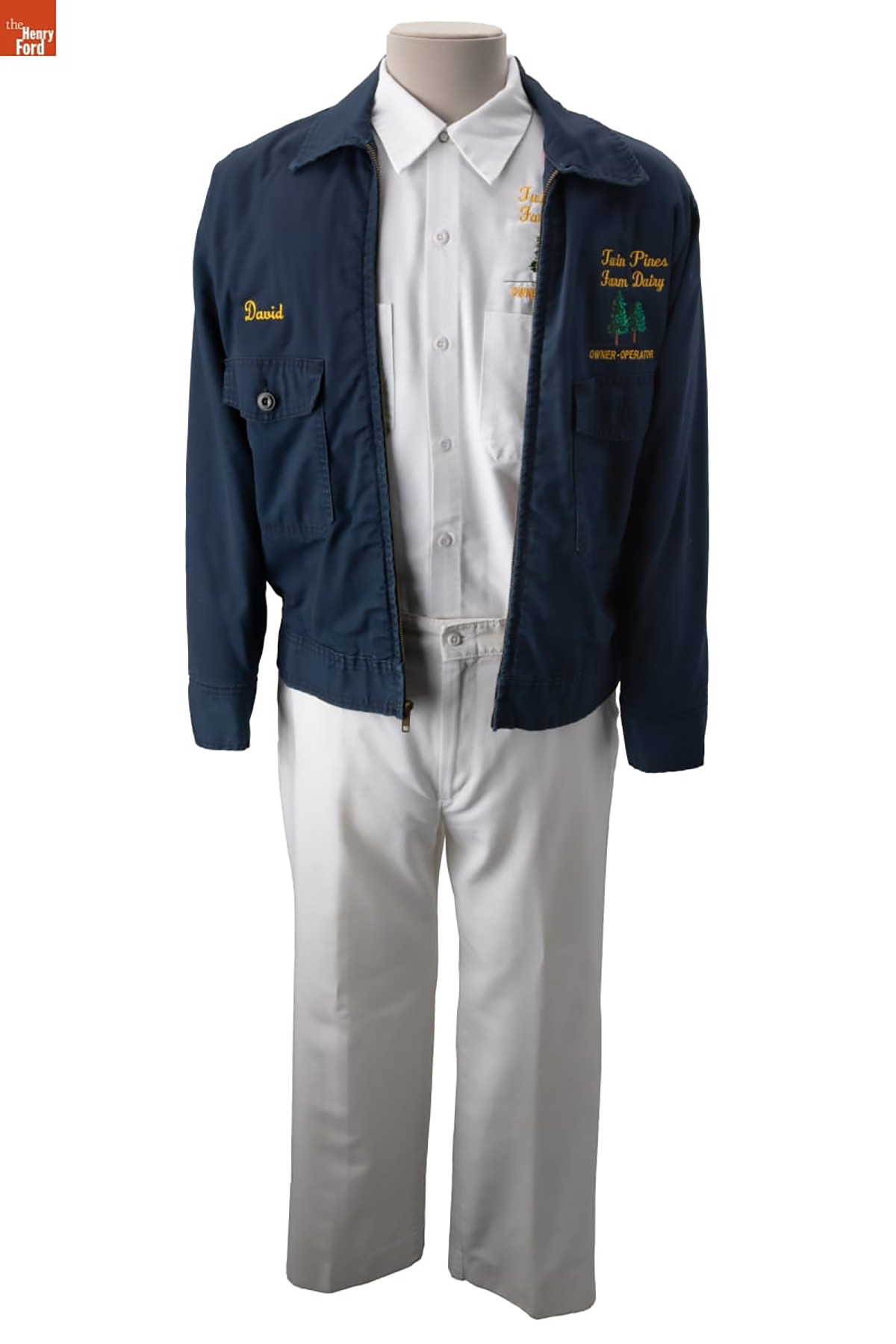
Twin Pines Dairy delivery uniform, about 1993. Worn by David Ivanko of Birmingham, Michigan. THF371986 Gift of John M. Ivanko.
There was a time when many households had a “milkman” who regularly delivered bottles of cold, fresh milk — in the 1950s, more than half of consumer milk sales came from these home delivery services. Customers conveniently placed standing orders but could change the order by leaving a note in one of the returned empty glass milk bottles. A dramatic increase in two-car families and small convenience stores changed things by the mid-1970s. Today, doorstep milk delivery is uncommon.
Twin Pines Dairy trucks were a familiar sight on the streets of the Detroit metro area in the 1950s and 1960s, covering approximately 500 delivery routes. During the time that John Ivanko of Birmingham, Michigan, owned a route in his wealthy Detroit area community, home delivery routes were far fewer — his was one of only about 50 in 1993.
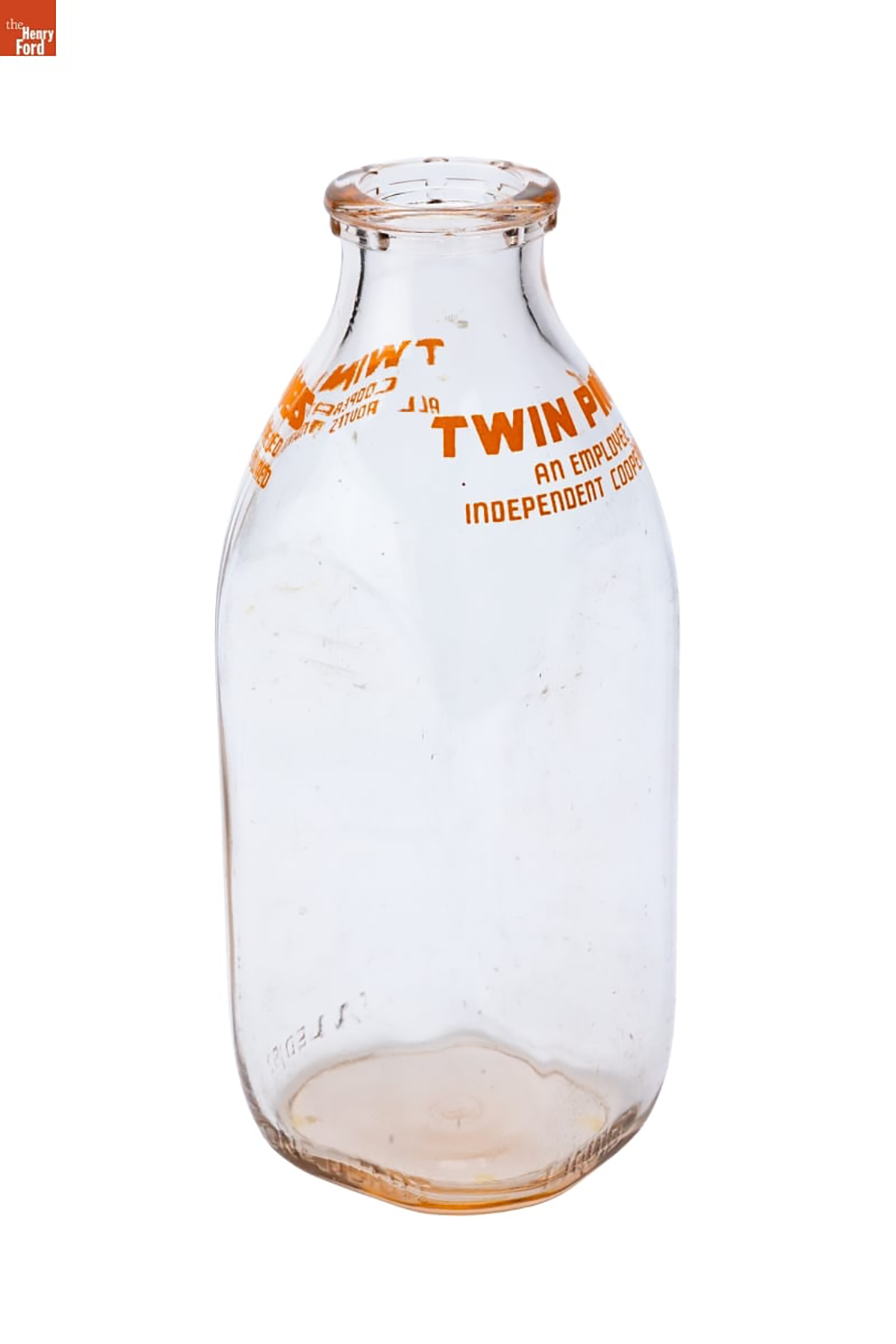
Twin Pines milk bottle, about 1950. Twin Pines Farm Dairy was an employee-owned, independent cooperative, whose delivery routes were also independently owned and operated. / THF800558 Gift of Gail S. Woodruff.
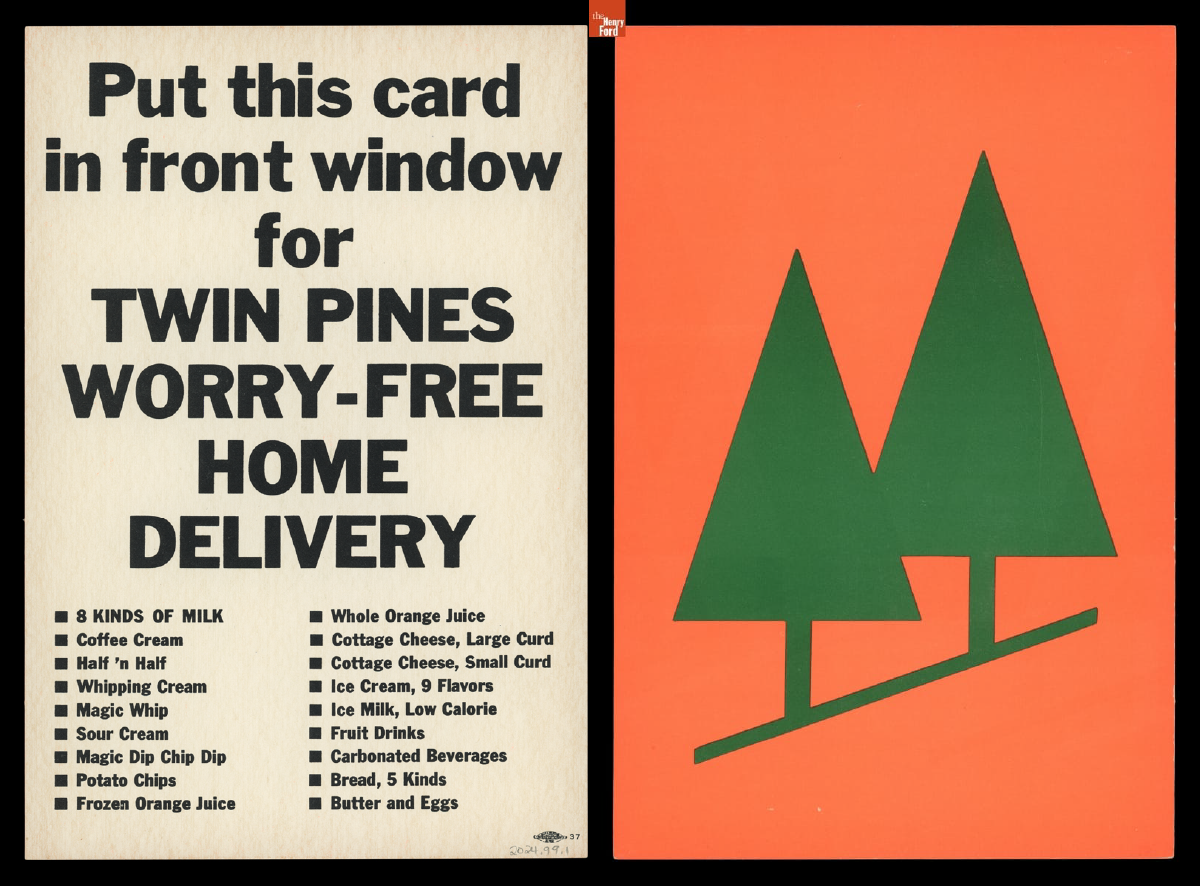
This Twin Pines window card lists the variety of products available for convenient, “worry-free” home delivery, 1965-1975. / THF718810, THF718809
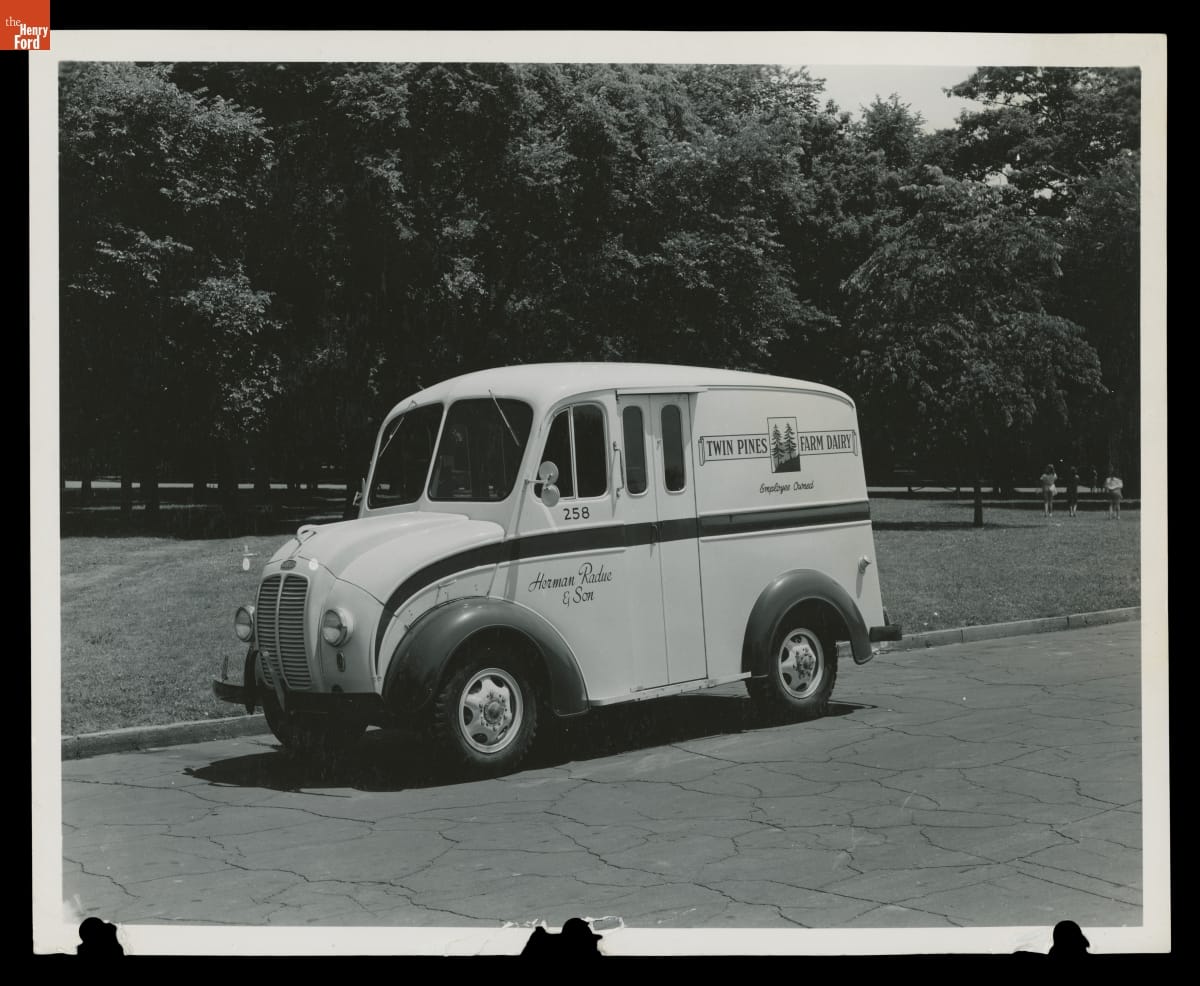
Twin Pines Dairy drivers delivered their products to customers in trucks manufactured by the Divco Truck Company of Detroit, Michigan, shown in this late 1950s photo. / THF717898 Gift of Ralph Seabright.
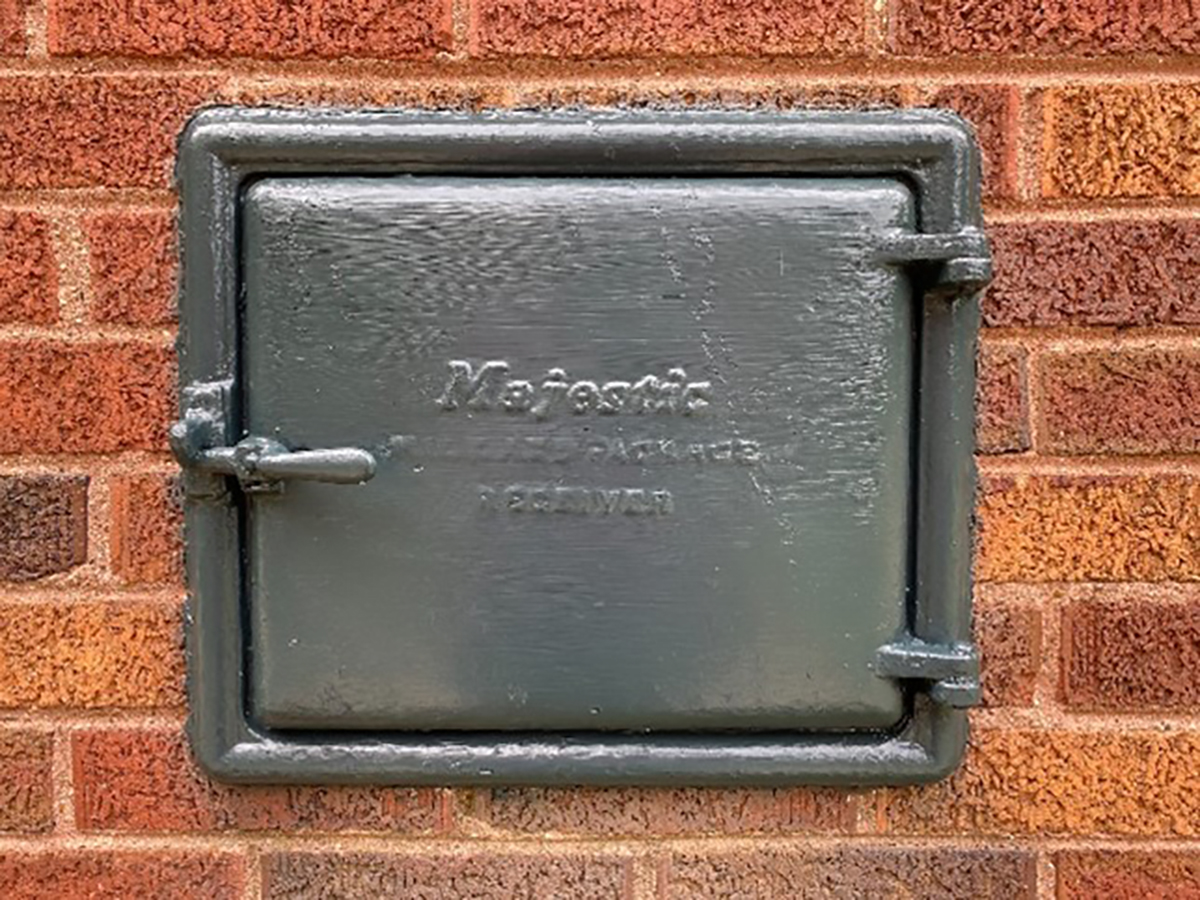
Some homes had “milk chutes” built into a wall. Delivery workers opened the compartment from outside the house. Customers retrieved the milk through another door inside. Image courtesy of Kate Herron.
Jeanine Head Miller is curator of domestic life.
Moving Boldly
Dancer Martha Graham was formidable in her work, art and life.
Born in Allegheny, Pennsylvania, in 1894, Martha Graham first became captivated by dance when, at 17 years old, she saw Ruth St. Denis — known even then as a pioneer for drawing influence from Asian dance forms — perform in Los Angeles. In 1916, Graham joined the Denishawn dance troupe (co-founded by St. Denis and her then-husband and dance partner, Ted Shawn), and began a performance career that would continue until her retirement from the stage at age 74.
In 1926, Graham founded the Martha Graham Dance Company with herself as principal choreographer. Her work would come to define modern dance, with her technique creating the first teachable methodology. Eschewing the delicate, airy aesthetic of traditional ballet, Graham’s choreography was grounded, focusing on the contraction and release of the body, originating in the solar plexus. Sharp, sometimes harsh movements, interrupted by moments of spiraling fluidity, were used to convey an emotional reality in each performance.
Early in 2024, The Henry Ford acquired five color slides documenting the creative collaboration between Graham and designer Isamu Noguchi. Noguchi designed sets for over 20 of the company’s performances (including Graham’s most notable work, Appalachian Spring), his spare but innovative designs pairing perfectly with Graham’s choreographic style. The images capture dancers in action among Noguchi’s set pieces, evoking the energy and reality of the performances in a way that programs or other ephemera would not.

Slide images from performances of (clockwise from bottom) Acrobats of God (1960), Seraphic Dialogue (1955) and Frontier (1935). Photo by EE Berger.
Martha Graham’s importance lies not just in her choreography; the same thread of boldness ran throughout her life. Years after her death in 1991, she is remembered for her forceful personality — she was known for pushing herself and those around her, inspiring in many an intense devotion to her and her teachings — and her unflinching commitment to telling feminist stories through her works, which often included unvarnished depictions of female power and sexuality.
Collecting her work — even in the smallest of images — allows The Henry Ford to explore more of Graham’s dynamic story.
This post was written by Rachel Yerke-Osgood, associate curator, and adapted from an article in the Winter/Spring 2024 issue of The Henry Ford Magazine.
Industry Evolution
2024 marks two milestone anniversaries for the Ford Rouge Complex
By Paige Gilbert, social media manager, The Henry Ford
One hundred years ago, in 1924, Henry Ford opened the massive Ford Rouge Complex for the public to see and experience the manufacturing process. By 1936, a memorable phase of Rouge tours began. The Ford Rotunda — originally designed for the 1934 World’s Fair — reopened as a visitor center and starting point for tourgoers who boarded glass-roofed buses to see the massive complex. Some of today’s guests still remember walking through the steel operations plant.
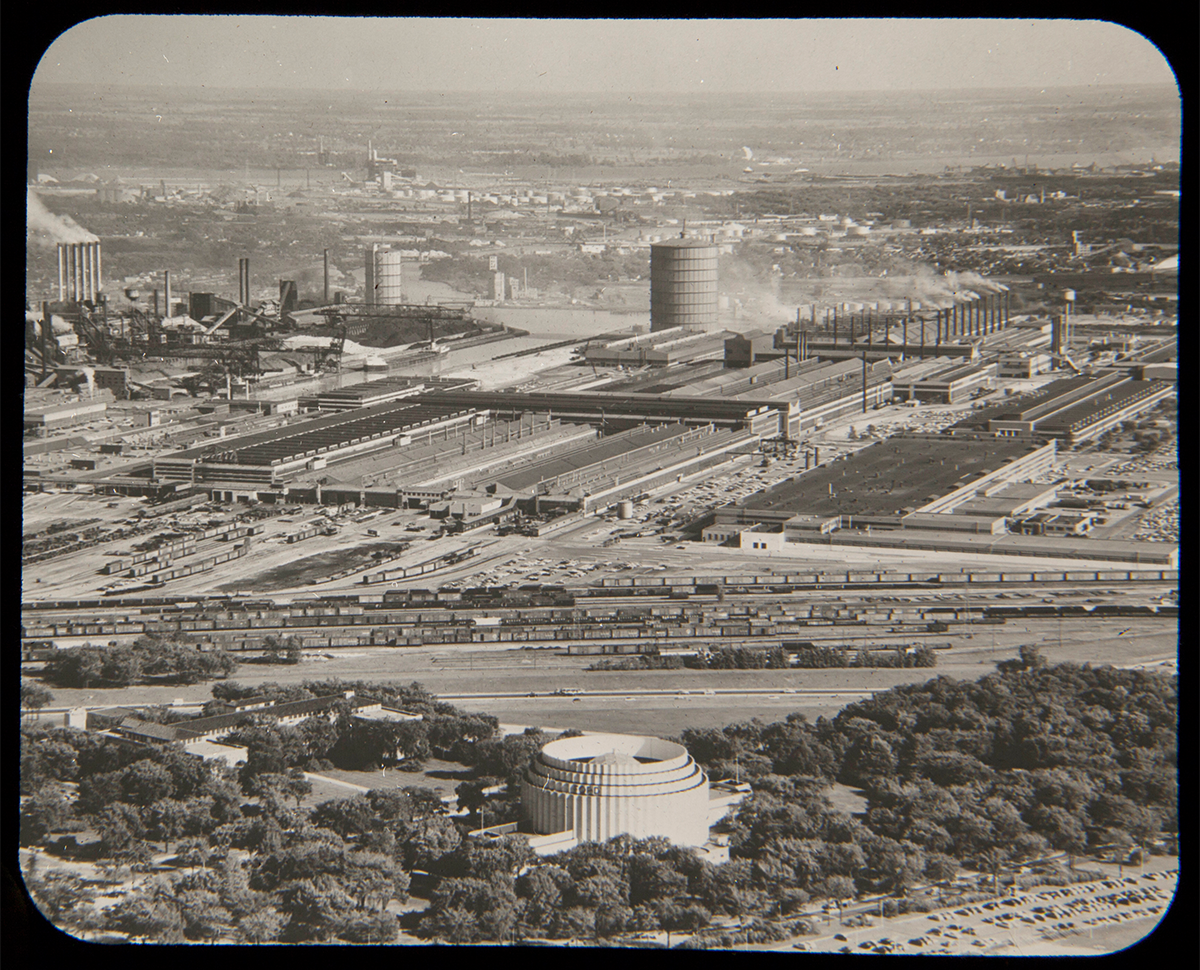
Ford Rouge Complex circa 1955 / THF274424
After a 1962 fire destroyed the Rotunda, Ford Motor Company opened a building called the Spirit of Ford directly across from Henry Ford Museum of American Innovation and bused tour attendees from there to the Rouge. In the early ’80s, Ford stopped offering factory tours for various reasons.
In the late ’90s, Bill Ford, then chairman of Ford’s board, began to reimagine a Rouge Complex of the future. He brought on architect and designer William McDonough to help make the Rouge more efficient and sustainable. Together, they envisioned a site that could become a model of industrial production and environmental redesign. The complex saw many transformations — including new approaches to stormwater management, landscaping, waste minimalization and lighting, as well as the creation of one of the world’s largest “living roofs.”
With this redevelopment came the opportunity to build a visitor center and reopen the factory to the public. The visitor center project came to life through a collaboration between Ford Motor Company, The Henry Ford and UAW Local 600.
Twenty years ago, on May 3, 2004, the Rouge reopened to the public, this time with tours managed by The Henry Ford. Today, Ford Rouge Factory Tour guests are bused from Henry Ford Museum of American Innovation to be immersed in the past, present and future of American manufacturing as they get an inside look at where the Ford F-150 is assembled.
Since 2004, the Ford Rouge Factory Tour has welcomed more than 2 million guests from all over the world.
This post was adapted from an article in the Winter/Spring 2024 issue of The Henry Ford Magazine.
J.Edison Grain Sack: 2024 IMLS Conservation Feature
A team of staff from five departments at The Henry Ford have been busy during the final three weeks of an exciting IMLS grant project. Over the last two years of this grant-funded project (October 2022-August 2024), the efforts of conservation, collections management, cataloging, the photography studio, and curatorial, have led to the treatment and interpretation of 2,106 items stored in THF’s Collections Storage Building. Read on to explore behind-the-scenes work in the conservation lab!
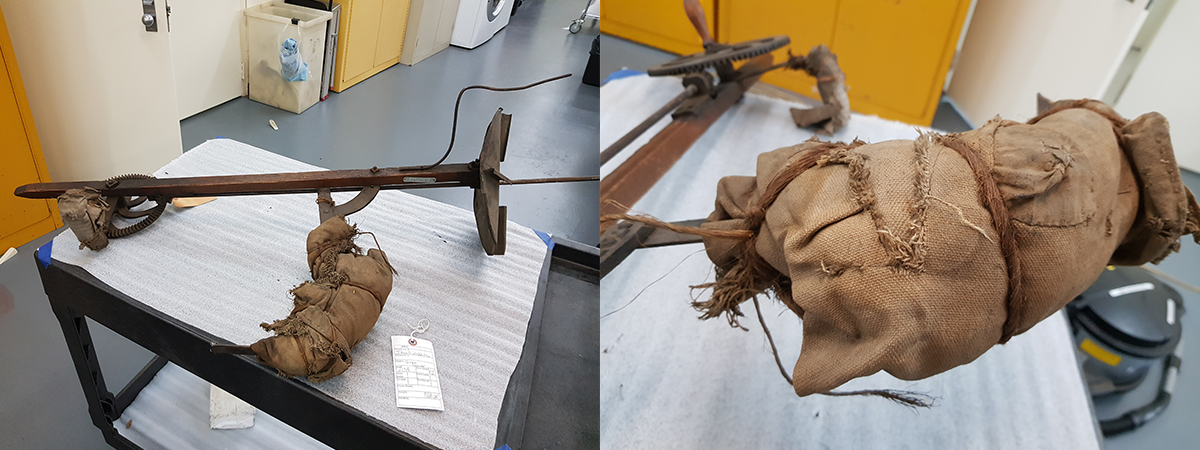
Broadcast Seeder with parts wrapped in fabric / Reference Images by Jeeeun Sims (Jee Eun Lim) / 00.1384.23
This object might make you scratch your head, but it held clues that curators and cataloguers explored as conservators completed their work.
Conservation of the object started with a thoughtful study to determine next steps for treatment. This required unwrapping fabric and straw bound around two of the metal components. This was likely done by the donor to protect people from injuring themselves on the sharp metal while handling the object.

Grain Sack / Reference Images by Jeeeun Sims (Jee Eun Lim) / 00.1384.23
One of the fabrics was a grain sack with the word “J.EDISION” stenciled in orange paint on the outside, front and back. The sack included torn areas that had previously been mended.
The level of dirtiness was first checked with wet paper and deionized water. Next, the bag was vacuumed to remove residual substances such as large pieces of dust and insect carcasses. During this process, we found a few grain seeds that were placed separately in a plastic bag for future research.

Grain Sack / Reference Images by Jeeeun Sims (Jee Eun Lim) / 00.1384.23
After vacuuming, conservators worked with textile Conservation Specialist Katrina Herron to perform a wet cleaning. The bag was submerged in a tray filled with tap water. The bag was lightly agitated to remove dust and contaminants. The water was replaced and the process repeated until the water was clear enough to call the bag “clean.” While changing the water, the bag was rolled with a mesh sheet and set aside. This technique reduces the likelihood of damage to the bag when carried flat, as the weight of the water can cause too much tension to the fibers.

Grain Sack Treatment / Reference Images by Jeeeun Sims (Jee Eun Lim) / 00.1384.23
The water was changed a total of fourteen times. At the beginning of the process, the dust and contaminants were removed with only tap water. The next cycles used tap water mixed with liquid soap. Orvus and Vulpex are gentle cleaners used by our conservation staff. In this project, they were used to clean the stains on the surface of the bag by pressing it with a soft sponge. In the end, deionized water was used to rinse out the soap thoroughly. Each time the water was replaced, a sample of the water was taken to determine the level of contamination.

Grain Sack before, during, and after treatment / Reference Images by Jeeeun Sims (Jee Eun Lim) / 00.1384.23
After completing the wet cleaning process, the bag was left to air dry slowly on a mesh drying rack sandwiched between clean towels. The surface of the fabric is brighter after cleaning but still retains some stains that show its previous use.
As conservators treated the object, other members of the IMLS grant team explored additional clues to help with identification.
An attached tag reads: "GRAIN SOWER"/ "FROM: MR. + MRS. HAROLD EDISON"/ "GRAND RAPIDS." The description “Grain Sower” indicates that a farmer used the machine to sow wheat or other grains. Cranking the wooden handle turned a shaft topped with a flanged disc that broadcast the seed onto the field. An inscription on one of the cast metal components gave a patent date of March 22, 1870, and that led to U.S. Patent 101,136 for a “Broadcast Seeder.” The inventor, Jacob C. Kurtz of Wooster, Ohio, included illustrations with his patent, explaining that his device could rapidly and evenly distribute seed, and could also be adapted for use from a wagon.
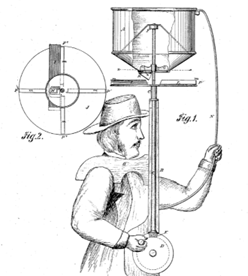
Illustration from U.S. Patent 101,136, issued March 22, 1870 to J. C. Kurtz, Wooster, Ohio / United States Patent and Trademark Office
J.EDISON, UNPACKED
How did Mr. and Mrs. Harold O. Edison acquire this machine? The donors, likely Mr. Harold Ogden Edison and his wife Cosetta A. Hessey, did not explain this history, but the grain sack with “J.Edison” stenciled on it provided a critical clue. Harold descended from the family of Moses Edison (1783-1849). Moses had a son, John, who likely purchased the broadcast seeder and had the grain sack stenciled “J.Edison.”
In 1837, Moses, his wife Jane Saxton (1787-1872), and several children including John (1806-1889) moved from Vienna, Canada, to Walker Township, Kent County, Michigan (the Grand Rapids area). This date derives from a reminiscence shared when the Moses Edison family donated their spinning wheel to The Henry Ford (Wool Wheel, C. 1800-1830 / THF176591). They settled on land north of the Grand River, which was previously occupied by Ottawa (Odawa), Chippewa (Ojibwa), and Potawatomi (Bodewadi) peoples, who were required as part of the 1833 Treaty of Chicago to move to Kansas territory.
Did the Edison families in Walker Township have any connection to Thomas Alva Edison? Yes.
Moses was a brother of Samuel Ogden Edison (1767-1865) who was Thomas Alva Edison’s grandfather—which meant that Moses was Thomas Edison’s great uncle, and John (the owner of the grain sack) Edison’s first cousin once removed. In 1933, Thomas Edison’s homestead was sold to Henry Ford and moved to Greenfield Village. The broadcast seeder treated during the IMLS grant was located in the Edison Homestead as of 1951, confirmed by a small aluminum plate attached to its base (E.H.-382) during an inventory conducted in the house that year.
Thanks to funding from the Institute of Museum and Library Services, this broadcast seeder led to in-depth conservation treatment, while also prompting exploration of the stories connected to it, including removal, migration, agriculture, and familial connections over decades.
This blog was produced by Jeeeun Sims (Jee Eun Lim), Conservator, with Debra A. Reid, Curator, Agriculture and the Environment.

